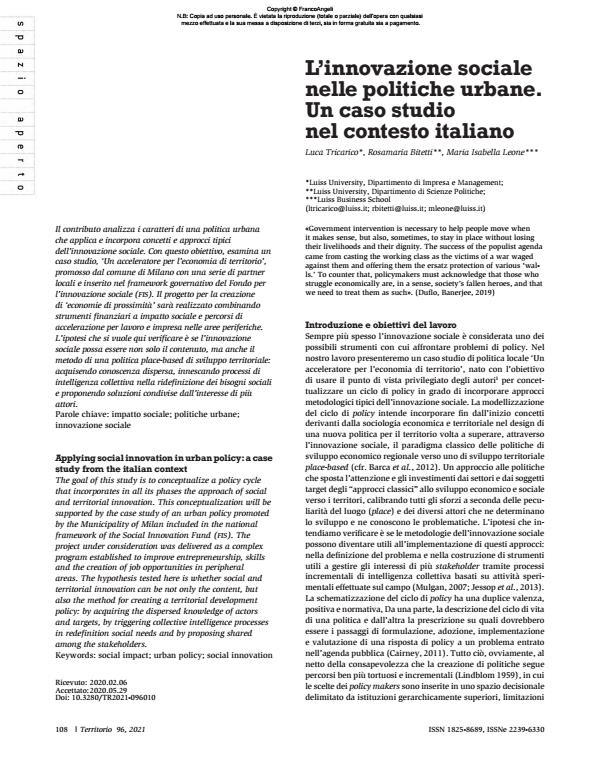Applying social innovation in urban policy: a case study from the italian context
Journal title TERRITORIO
Author/s Luca Tricarico, Rosamaria Bitetti, Maria Isabella Leone
Publishing Year 2021 Issue 2021/96
Language Italian Pages 8 P. 108-115 File size 793 KB
DOI 10.3280/TR2021-096010
DOI is like a bar code for intellectual property: to have more infomation
click here
Below, you can see the article first page
If you want to buy this article in PDF format, you can do it, following the instructions to buy download credits

FrancoAngeli is member of Publishers International Linking Association, Inc (PILA), a not-for-profit association which run the CrossRef service enabling links to and from online scholarly content.
The goal of this study is to conceptualize a policy cycle that incorporates in all its phases the approach of social and territorial innovation. This conceptualization will be supported by the case study of an urban policy promoted by the Municipality of Milan included in the national framework of the Social Innovation Fund (fis). The project under consideration was delivered as a complex program established to improve entrepreneurship, skills and the creation of job opportunities in peripheral areas. The hypothesis tested here is whether social and territorial innovation can be not only the content, but also the method for creating a territorial development policy: by acquiring the dispersed knowledge of actors and targets, by triggering collective intelligence processes in redefinition social needs and by proposing shared among the stakeholders.
Keywords: social impact; urban policy; social innovation
- Towards a Paradigm of Proximity Economy for Competitive and Resilient Cities and Territories Luca Tricarico, Pierre Hausemer, Nessa Gorman, Francesca Squillante, in Social Sciences /2025 pp.394
DOI: 10.3390/socsci14070394 - The Impact of COVID-19 on Public/Third-Sector Collaboration in the Italian Context Luigi Corvo, Lavinia Pastore, Marco Mastrodascio, Luca Tricarico, in Sustainability /2022 pp.2228
DOI: 10.3390/su14042228 - New Metropolitan Perspectives Luca Tricarico, Luigi Corvo, Lavinia Pastore, Arda Lelo, pp.471 (ISBN:978-3-031-06824-9)
- Innovazione sociale: cosa cambia per la governance urbana? Una riflessione a partire dai casi di Inghilterra e Francia1 Francesca Bragaglia, in ARCHIVIO DI STUDI URBANI E REGIONALI 140/2024 pp.102
DOI: 10.3280/ASUR2024-140005
Luca Tricarico, Rosamaria Bitetti, Maria Isabella Leone, L’innovazione sociale nelle politiche urbane. Un caso studio nel contesto italiano in "TERRITORIO" 96/2021, pp 108-115, DOI: 10.3280/TR2021-096010